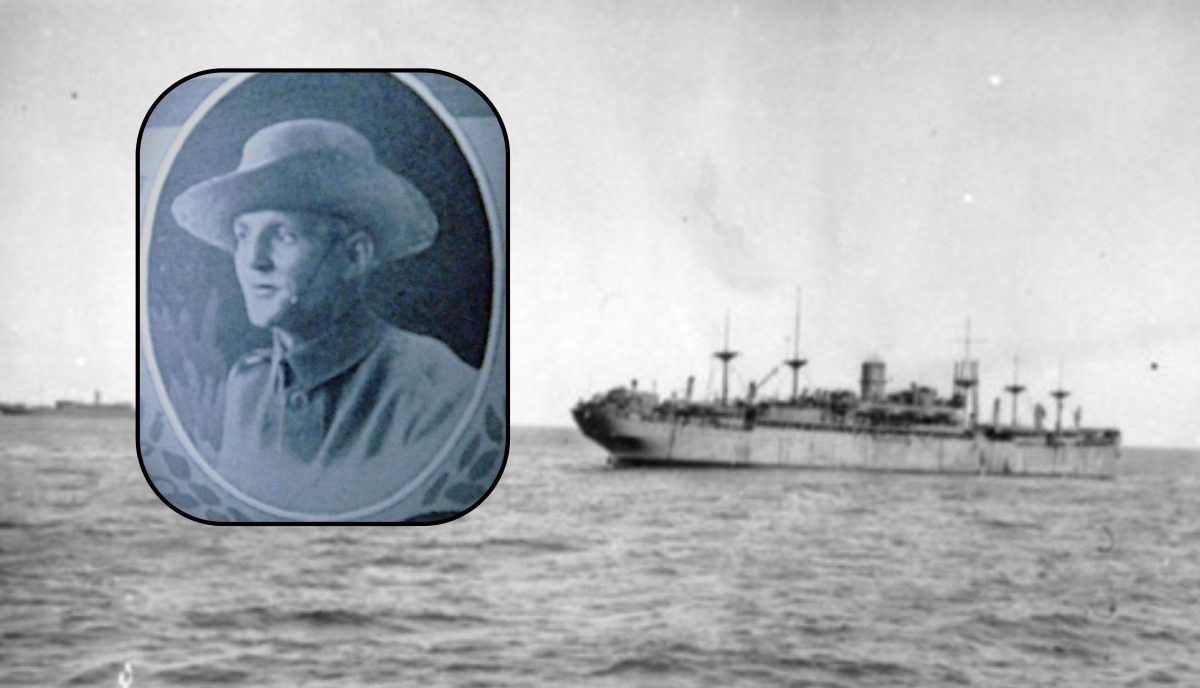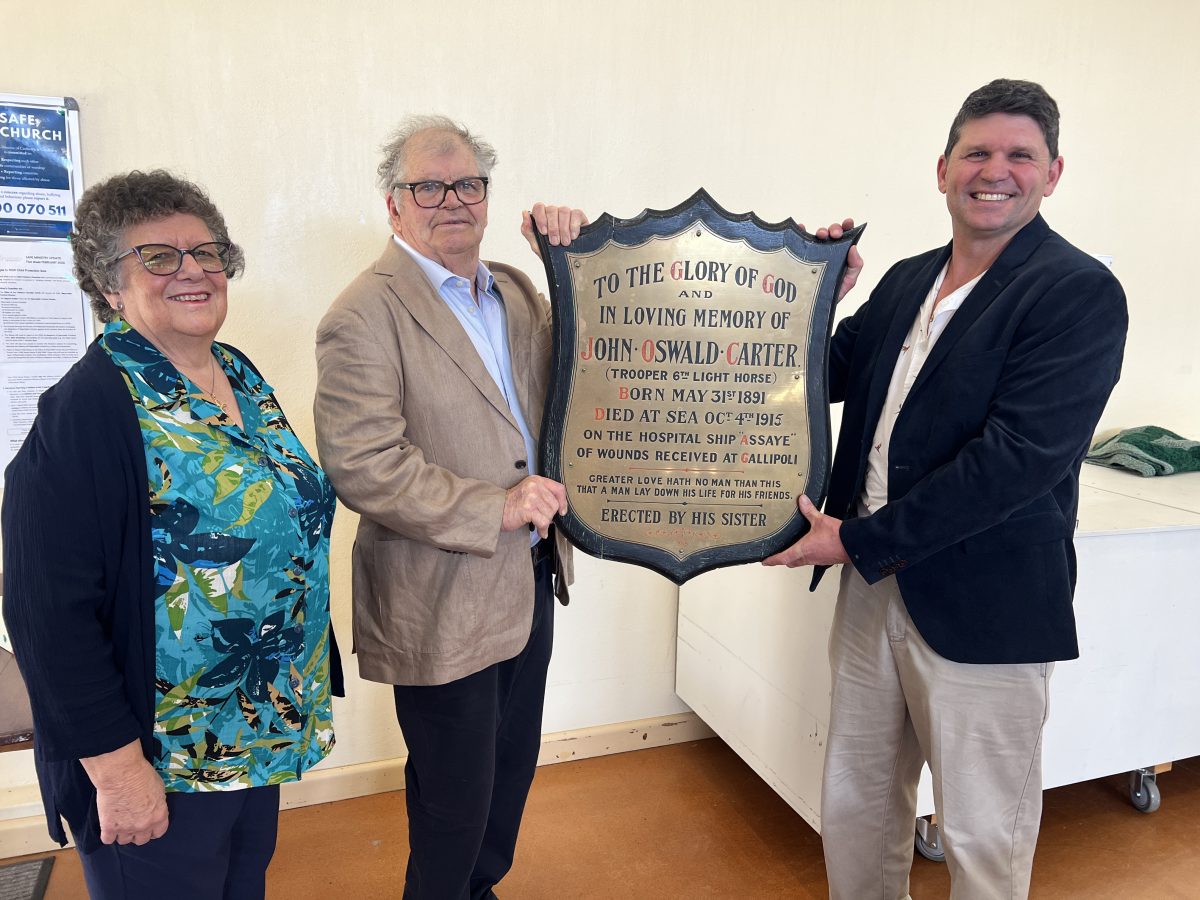
Trooper John “Jack” Oswald Carter (inset) and HMAT Shropshire during World War One. Photos: Australian War Memorial.
A forgotten plaque tucked away in a church storage room in Young has reconnected a former local family with a soldier’s story of sacrifice more than a century after his death.
Trooper John “Jack” Oswald Carter was just 24 years old when he died of wounds sustained at Gallipoli.
A member of the 6th Australian Light Horse Regiment, the slight, dark-haired Jack was struck by shrapnel to the head during the brutal campaign and died of his wounds at sea aboard the hospital ship Assaye on 4 October 1915.
Buried at sea, his name is etched on the Lone Pine Memorial in Turkey, where Australia recently marked the 110th anniversary of the Gallipoli landing.
At home, just a few miles down a dirt road from the family farm, a memorial service in Jack’s honour was held at St Luke’s Anglican Church, Thuddungra on 20 December 1915.
According to records, the tiny weatherboard church – decorated in flags – was filled to capacity and, had it not rained, the crowd, who had travelled from near and far, would have overflowed into the churchyard.
For his family in the Young district, Jack Carter’s wartime service was also remembered through a brass plaque dedicated by his sister, Elinor Peterson (nee Carter), when St Thomas’ Anglican Church at Lirambenda – also near Young- was built on land gifted by the Carter family.
The plaque honoured the younger son of James and Mary Carter of “Kikiamah” and “Rosedale”, Moss Vale.
When St Thomas’ Church was sold in 2007, the memorial disappeared from view.
Placed into storage at St John’s Anglican Church in Young, it remained unnoticed until parish council member Pauline Davidson came across it earlier this year.
“I saw it tucked away and knew it deserved more than gathering dust,” Pauline said.
“I was interested to see what the story was behind it and whether it could go back to a family member, if I could find the correct family connections.”
She began researching the name and piecing together Jack’s story before reaching out to surviving relatives.
On Sunday 10 August, during the 160th anniversary service of St John’s, the plaque was formally handed back to Carter’s descendants.
Great-nephew Charles (Charlie) Carter and his son, Charles, accepted the plaque on behalf of the family.
Born on 31 May 1891, John Oswald Carter was educated at Melbourne Grammar School.
When the First World War broke out, he was in Scotland and could have sought a commission with Lord Lovat’s Scouts.
Instead, he chose to return home and enlist alongside fellow Australians.
He enlisted in December 1914 and trained with the 6th Light Horse Regiment, assigned to 2nd Light Horse Brigade’s command under Brigadier General Granville de Laune Ryrie.
After embarking from Sydney on the HMAT A9 Shropshire in May 1915, Jack was based near Maadi Camp near Cairo in Egypt where troops were involved in defensive training and garrison duties while awaiting deployment.
He would deploy to Gallipoli with the regiment’s “B Squadron” in July of the same year.
The terrain at Gallipoli was deemed unsuitable for mounted operations.
As a result, the 6th Light Horse – and other Light Horse regiments – landed without their horses to serve as infantry reinforcements taking up a sector on the far right of the ANZAC line at Gallipoli, where they served in a defensive role around Bolton’s Ridge and Holly Spur.

Pauline Davidson of Young’s St John’s Anglican Church Parish Council with Charles Carter and his son Charles, holding the plaque commemorating John “Jack” Oswald Carter which was recently returned to the family. Photo: Maree Myhill.
Alas Jack Carter would only see three months of action before he was wounded in a communications trench.
But for his service, he was posthumously awarded the 1914–15 Star, the British War Medal and the Victory Medal.
Fifty-two years later, his still-grieving sister Elinor also made representations to have the Gallipoli Commemoration Medal conferred in Jack’s honour.
The Carter family had long ties to the Young and Grenfell districts.
Their property “Kikiamah”, near the small farming settlement of Thuddungra, was renowned for its prize-winning shorthorn cattle and successful pastoral operations under the stewardship of Jack’s father James, and later his older brother, Charles Atkinson Carter.
For the present-day Carters, now living in Sydney, the return of Jack’s plaque has brought the story full circle.
“They were very thankful for its return,” Pauline said.
What was once hidden away is now restored to family hands, ensuring that Trooper John Oswald Carter is not forgotten.
He was honoured at a Last Post ceremony at the Australian War Memorial on 22 June 2017.
His name will also be projected onto the exterior of the Australian War Memorial’s Hall of Memory at 11:02 pm on Thursday 4 September.







